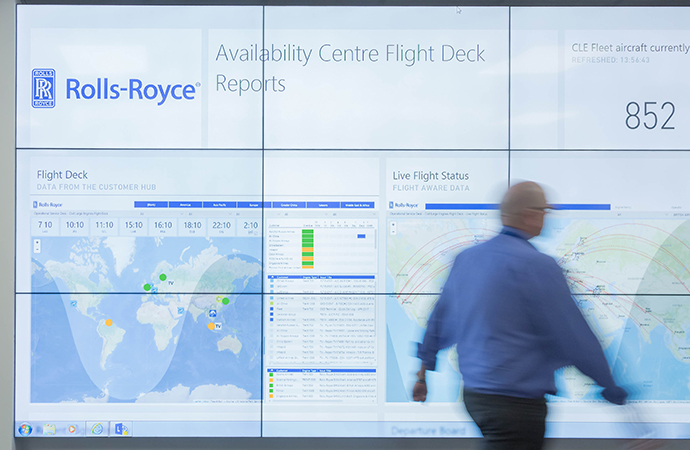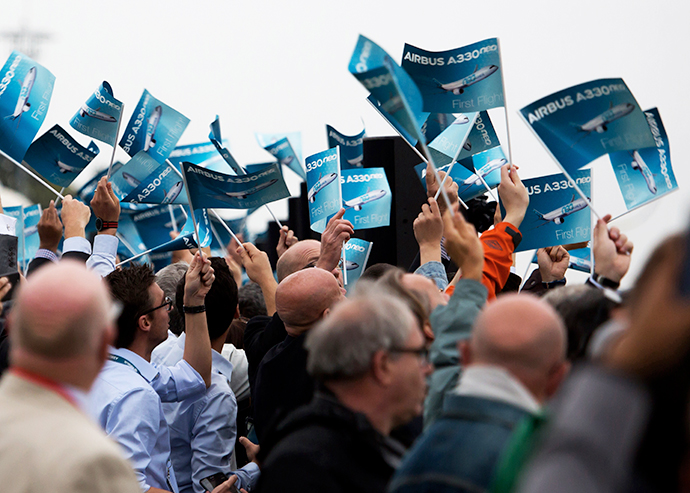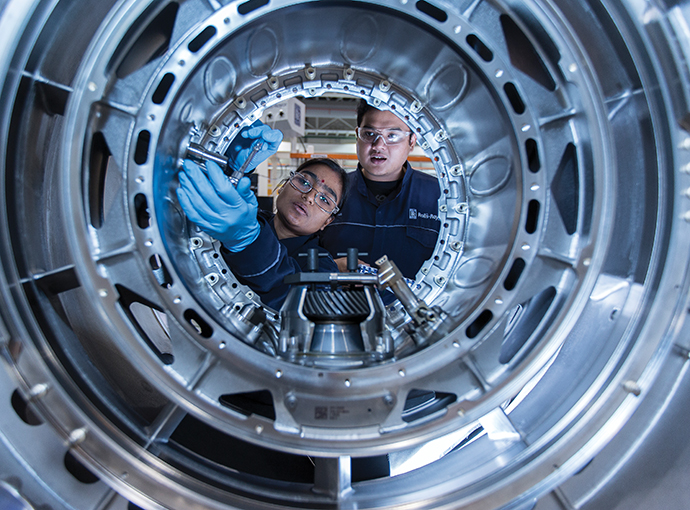When the Rolls-Royce Trent 7000 engine took to the skies on an Airbus A330neo in Toulouse, France, in October, it marked the third “first flight” for a Rolls-Royce engine in less than one year. That unprecedented achievement in aerospace meant bringing together more than 20,000 parts for each engine’s program, then putting those engines through rigorous testing at a number of test beds and facilities around the world — part of a global operations portfolio encompassing 30 million sq. ft. (2.8 million sq. m.).
Civil aerospace is only one business of Rolls-Royce, one of the United Kingdom’s most prized brands, which also operates defense aerospace, marine, power systems and nuclear power businesses. The company’s MTU brand makes high-speed diesel engines powering applications such as locomotives and luxury yachts. Recent facility investments by Rolls-Royce have included a new joint engine depot with the US Air Force at Tinker Air Force Base’s Oklahoma City Air Logistics Complex; a £150-million (US$187-million) investment in new and existing civil aerospace facilities in the UK, including a large engine Maintenance Repair & Overhaul (MRO) facility in Derby, as well as manufacturing facilities in Derby and Hucknall, Nottinghamshire. The company also decided to retain the Precision Machining Facility (PMF) in Derby, which it previously had announced would be closed. Site Selection tracked a 200-job investment in Ropczyce, Poland, earlier this year, and the company invested $700 million in an 800-job project in Singapore in 2015.
At the Paris Air Show in June, the company, Purdue University and the State of Indiana announced a new $24-million, jointly funded program that will establish unique gas turbine research capabilities at Purdue’s Zucrow Laboratories which will focus on advanced turbine aerodynamic and heat transfer technologies. Purdue has 40 faculty and graduate students working on current Rolls-Royce research projects. Rolls-Royce will apply these technologies to jet engine airfoil components in engines produced at the company’s Indianapolis facilities, where the company is spending $600 million to modernize its Indianapolis facilities and to conduct technology research.

The company spent £1.3 billion ($1.63 billion) on R&D in 2016, supported in part by a global network of 31 University Technology Centres. In 2016 Rolls-Royce recruited 274 graduates and 327 apprentices through its training programs. The company employs 50,000 people in 50 countries — more than 16,500 of them are engineers.
Behind all that engine and brain power is a real estate and facilities organization charged with supporting the business in optimizing company facility asset performance in order to compete with the likes of GE, and Pratt & Whitney. Helping lead that team is Robert Brown, Director, Global Operations, for Rolls-Royce, Group Property. His email signature includes the admonition, “Always remain curious and interested.” So when we finally caught up with him on a Monday in October after he’d come to the US from the UK, we asked a few questions.
Where are you right now?
Robert Brown: I’m in an American Airlines lounge in Charlotte, on my way to Indianapolis. It’s normally pretty quiet, but I’ve had problems with my phone and computer. There’s a 6:30 a.m. meeting I chair on Tuesdays — it’s global and I have my team for 60 minutes a week to catch up on what is happening in China, India, Singapore, UK, Americas, Germany and other locations around the world. The time slot was to capture all team members as it is a 12-hour time difference. You live and die with the technology.
Describe your organization’s portfolio, structure and way of working.
Robert Brown: The organization I work in is called Group Property. Ian Campbell is the Global Leader within the organization. We have four pillars. They are all global and cover Americas, APAC, & EMEA. The area I am accountable is Global Operations. The team is responsible for Facilities Management. The other areas are HSE [Health, Safety and Environmental Compliance] & Energy, Planning and Projects. Typically, Planning is the group that works with the business for new space and major project development.
I have 28 people on my team that work for Rolls-Royce, and about 1,500 service partners around the world. The team and our service partners cover about 30 million square feet, split among manufacturing, office and warehouse. We own most of our manufacturing sites and we lease many of our offices. The majority of the space is manufacturing and covers about 65 percent of our portfolio. The largest sites are in Derby, U.K.; Friedrichshafen, Germany; , Indianapolis, USA; and our largest site in APAC in Singapore.
I’m on the road about 60 percent of the time. My travel is to the UK, Indianapolis, followed by Germany, the Nordics, Singapore, India and China and other locations, as needed. It is safe to say I am a frequent traveler.
Technology is a powerful way to engage our team, but it can never replace the face-to-face and cultural exchange with people. As an engineer and MBA, I enjoy all aspects of the Rolls-Royce business: from problem solving and developing fit-for-purpose solutions to enable the business to get product out the door. I have been lucky enough to work with a smart, culturally diverse team. The Global Operations team members are the best group of talent people that I have worked with in my 25 years.
Give us an idea of the company’s decision-making process behind recent location and expansion investments.
Robert Brown: The Global Planning team supports the business with the scheme development and total cost for real estate and on-going Operations. This data is part of the business case. As with any business case, there must be a Return on Investment (ROI) for the Rolls-Royce senior leaders to approve the scheme.
There are a number of ways the location(s) is decided. The process takes into account where our customer is going to be, and all modes of logistics — land, sea and air. For example, we built a plant in Poland. It was a joint venture between Rolls-Royce and Hispano-Suiza (Safran). The venture capitalized on its parent companies’ combined experience and expertise, encompassing the capabilities of Hispano-Suiza in the design — and production of accessory drive trains, and the engine design and propulsion system integration skills of Rolls-Royce. Based on an initial exclusive 25-year contract, Aero Gearbox International will cover the entire range of civil aircraft, from business jets to wide-body commercial jets.
The decision-making process examines logistics; the cost of doing business in that area — similar things you’d look at for any specific space in any area of the world, including what governments or local groups may want to give in terms of economic development incentives. Technical talent to work in the factory is another consideration for the area selected.
We hear a lot about the incredible number of aircraft that are going to be needed in fast-growing places such as India and China. How is your team assessing locations to serve these dynamic nations in particular?
Robert Brown: Currently we manufacture from 200 to 300 large engines a year. We’re going to ramp up to double that number from 2020 and beyond. The investment Rolls-Royce will need to make is substantial. There is planning in progress to best determine to expand in existing operations or other locations. The best use of funds will require strong planning. Group Property team is ready to support the business.

Rolls-Royce has moved some of the engineering business and call centers to India over the past year. There are current plans to expand our presence in India. We’re an engineering company first. India is recognized for top talent in engineering. Rolls-Royce wanted to take advantage of the talent because one of the driving factors is a lower cost base for the talent there.
Asia Pac is also a major growth area for the world economy and will be our largest growth area in the future. The GDP in India and China is the highest in the world and will continue in the next five to 10 years. When you think about office space — call centers and engineering space — India is a premier location. You have to be where your customers are going to be. We are now in India and growing. We want to leverage the technical expertise. Rolls-Royce is a bit more conservative, because we’re not as big as GE, United Technologies (UTC) and Pratt & Whitney. Therefore, we feel that we have to do a lot more due diligence.
How do you build lessons learned into your ongoing project work?
Robert Brown: We try to do that every time we build a new site or venture into a new operation. Once a site is commissioned, the Global Operations team is up and running, to manage the Operation. There are always lessons learned, and challenges at a particular site. Planning, Projects and Facilities have to work as a team to ensure the business is supported and the site is fit-for-purpose. There is Lean Process that is also followed from Stage Gate Zero to completion.
Rolls-Royce has divisions that can prosper through cross-fertilization. Describe how your team’s work reflects this sort of thinking.
Robert Brown: Group Property is responsible to support all five businesses throughout the portfolio. But one shoe doesn’t fit all. We do have a standard model for all businesses around statutory requirements; to maintain compliance is part of our DNA. When it comes to statutory requirements, we have over 50 control standards. For example, electrical safety is non-negotiable; we must keep our people free from harm.
The Operations team has to be flexible. In Indianapolis we’re insourced. In the rest of the states the operations are outsourced. But when it comes to operations, we have to have some flexible on-service delivery. And of course, we have unions and work councils that we have to work with around the globe.
As you continuously evaluate locations worldwide, what sorts of business intelligence are most routinely difficult to find?
Robert Brown: When you think about the Americas and how some states have “right to work” statutes or are union represented, we have rules of the road that we must follow, or at a minimum, negotiated. For example, in Germany, the work councils are really strong. Wherever you work, you have to take into account the local environment and labor laws. That is intelligence we need to know before locations are selected. You have to determine the long-term cost to do business in a specific area. Life-cycle cost of assets needs to be part of your evaluations to determine the first cost. In 10-15 years, what will the location or country be in terms of costs, labor and environment?
For life-cycle costs, we benchmark across all countries. If we are to remain at a location, it may be best to refurbish, rather than to build new. GE or Pratt & Whitney may spend $250 million or $300 million on a new greenfield plant. Rolls-Royce may approach it differently, by utilizing what we have and build onto an existing location. That was a decision made by our Defense aerospace business to stay in Indianapolis. There are always many darts on the board. No single decision stands alone.

